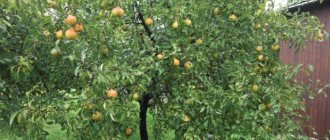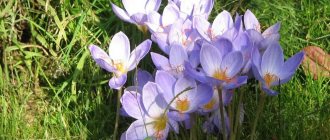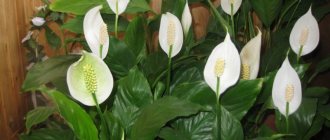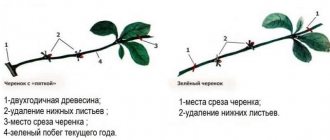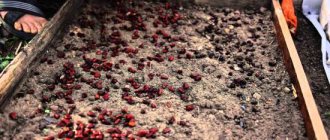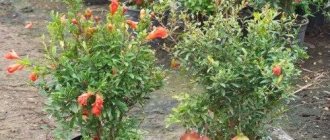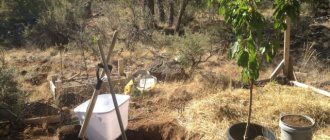General rules for reproduction
Temperature and humidity
Maintaining temperature control is the first step to success. Indoor azaleas come from the rhododendron family, most often dwarf Indian or Japanese. Adult rhododendrons love cool weather, but their reproduction requires a higher temperature - 22-25 degrees. Constantly good soil moisture, regular spraying with soft, settled water. But all this without fanaticism - waterlogging threatens rotting of the roots and death. For better results, you can build a microgreenhouse, where it is easier to maintain the desired regime.
Soil composition
The flower loves loose, nutritious, acidic soil. The easiest way is to buy ready-made soil, or you can prepare it yourself.
It is composed as follows: 2 parts peat, 2 parts each coniferous and leafy soil, 1 part sand. It is good to add dried crushed sphagnum moss for disinfection. Adding hydrogel will help retain moisture and protect the bushes from drying out in case of untimely watering. A wide, low dish is suitable for planting; good drainage is placed on the bottom: expanded clay with a layer of at least 3 cm.
If the soil is homemade, it should be steamed in this way: pour it into a colander and place it in a pan of boiling water for half an hour. Or pour it onto a baking sheet and keep it in the oven at 100 degrees for the same 30 minutes.
Lighting
Rhododendron requires bright lighting, but direct sunlight is excluded. Ideally located on a western, northern window. Newly planted seedlings are shaded for a while.
Time to breed
With any vegetative method, the most suitable time for breeding rhododendron is spring and early summer. This is its natural time of active growth, after flowering.
Azalea description, photo
Azalea family Heather is a low evergreen shrub from 30 cm to 1.5 m. The leaves are small, shiny, lanceolate. Azalea flowers, collected in several pieces, grow from the axil of the leaf. The color range is very diverse; there are simple and double forms of the plant.
The most common is the Indian azalea (Sims rhododendron), which is grown as an indoor flower. Japanese azalea (another name for rhododendron obtuse) is an outdoor variety of flower. Azaleas prefer acidic soils. Therefore, the soil on which it grows well always includes peat and coniferous soil. The flower loves bright light, but cannot stand being in direct sunlight.
Important! A prerequisite for breeding azaleas is a decrease in temperature from mid-autumn to 6-8˚C, with a reduction in watering. In winter, azalea should be kept in a cool place at 12-15˚C.
Propagation of a bush by cuttings
Take green shoots from a healthy, well-developed plant.
Important: the current year’s growth is used for propagation. Lignified branches do not take root.
Cuttings
Using a sharp, clean knife, make an oblique cut, 1 cm away from the lower bud. Each shoot must have at least five leaves and a length of approximately 10 cm. Remove the two lower leaves, leaving half a centimeter of petioles. The remaining leaves are cut off, leaving half a leaf, and the top is pinched.
For successful rooting, the prepared planting material is treated with special preparations. The most suitable ones - “Heteroauxin”, “Kornevin”, “Zircon” - are used in accordance with the instructions.
Landing
Water the soil before planting - it should be very moist. The branches are planted vertically, deepening them by 2-3 cm, maintaining a distance between plants of at least 5 cm.
The temperature for rooting planting material is 22-25 degrees, and not only the air, but also the substrate should be warm.
If there are 1-2 branches, they are simply covered with a glass jar. You can place the bowl in a large transparent bag. If there are a lot of seedlings, arrange a microgreenhouse made of film. The purpose of the event is to maintain high air humidity (at least 80%) around the planted babies.
Care
Bowls with seedlings are placed in partial shade. Sprayed daily and ventilated in the morning. Monitor soil moisture. The seedlings are not watered, but the ground is sprayed with water at room temperature. Once a week, the water is acidified with citric and oxalic acid (2 grams per liter). Both drying out and waterlogging are detrimental to seedlings.
Small rhododendrons will take root and begin to grow in about 2 months. Turn the bowls in different directions towards the light so that the bushes do not bend. The appearance of new leaves is a sign that roots have grown. It's time to plant the bushes in separate containers.
Propagation of azaleas by cuttings - watch the video:
How does azalea propagate at home?
Follow the step-by-step instructions for propagating azaleas:
- Cut the cutting under the lower bud with a sharp, disinfected tool. Shorten the lower leaves.
- From the cutting site, make a longitudinal cut 2 cm and remove the bark a quarter of the cutting wide. This is necessary for the formation of roots.
- The next stage is treating the cuttings with a growth stimulator. You need to keep the cuttings in the liquid stimulant for some time. For example, in a solution of Heteroauxin it is 6 hours, and in Zircon it is 24 hours. If you use a powdered stimulant, for example, Kornevin, you need to sprinkle the sections with the prepared mixture.
- Before planting, treat the cuts with a manganese solution and deepen the shoot into moist soil by 2.5 - 3 cm. The soil can be prepared at home using the ingredients: coniferous soil, high-moor peat, sand. The soil should be light, so it is best to add Vermiculite to loosen it.
- Next, you need to cover with plastic wrap so that it does not touch the leaves of the plant and with a dark cloth.
If you are interested in breeding azaleas, we recommend that you familiarize yourself with the step-by-step instructions and features of the various propagation options.
Cuttings
Cuttings are an effective and frequently used method of propagating azaleas. The most acceptable period for cuttings is spring - summer season. However, if buds have not formed from December to February, the procedure can be carried out in winter.
Azalea cuttings photo
Important ! In winter, you need to take care of additional heating.
Different varieties of azaleas have distinctive reproduction characteristics:
- Green young shoots with immature buds are used for rooting deciduous varieties. Make sure the stem bends but does not break.
- To propagate evergreen varieties of azaleas, cuttings, which are characterized by lignification, are used. If the cutting breaks with a characteristic sound of wood, it is mature enough and suitable for cutting. Please note: the shoot must have at least 5 formed dark green leaves. The length of the shoot is 10 - 15 cm.
Rhododendron cuttings take root within 4 months. The recommended temperature for rooting is 22-27°C and air humidity 75-80%. The cuttings should be regularly sprayed and watered, but do not allow excess moisture.
If buds appear, they should be cut off so as not to increase the load.
Divisions of the mother bush
Why is it that the method of dividing the mother bush is actively used not only by beginning flower growers, but also by professionals? The reason is that each resulting bush is a full-fledged flower. It is convenient to combine the division of the mother bush with the annual replanting of the azalea after the flowering period. The procedure is most suitable for adult azaleas (at least three years old) with many shoots.
Reproduction of azalea by dividing the mother bush
To carry out the procedure correctly, adhere to the following rules:
- The plant is immersed in a container of water for 15 minutes, after which it is left for several hours. This will simplify the division procedure. When the excess liquid has come out of the soil, you can begin the main process.
- Be sure to disinfect the tool and work surface with alcohol. Use gloves, as azalea sap can cause skin irritation.
- Using a sharp knife or blade, separate the earthen lump with the roots. If the roots are tightly intertwined, untangle them by hand. Each part should have several developed shoots.
- Next, you need to prepare individual pots with a new substrate. We plant the cuttings at the same depth at which they grew before. Place expanded clay or pebbles at the bottom of the pot. The recommended thickness of the lower expanded clay drainage is from 2 cm, depending on the depth of the pot.
- After replanting, moisten the soil sufficiently.
- For a week you need to keep the container in a darkened room.
Important ! Dividing must be done with extreme caution so that the delicate roots are not subjected to severe mechanical damage.
Seeds
The seed method of propagation involves the germination of seed material taken from the mother bush.
Seed method of propagation of azaleas
Seeds are planted in early spring. It is best to take seeds that have been stored for no more than three months.
- A 3 cm thick expanded clay drainage is placed at the bottom of the container for the seedlings.
- Soil for azaleas can be purchased at a gardening store. To prepare it yourself, you will need coniferous soil, peat and sand.
- Moisten the soil and distribute the seeds evenly over its surface. There is no need to deepen or sprinkle with soil significantly.
- Cover the container with plastic wrap or glass.
- Germinating seeds must be provided with sufficient lighting. If your area does not have such conditions, be sure to consider artificial light sources. For example, fluorescent or phytolamps.
- The room needs good air circulation, so it is worth ensuring daily ventilation.
- When watering seeds, add oxalic acid (4 g per 10 liters of water) to water at room temperature.
- After two to three weeks, azalea seeds usually germinate.
- After germination of the cotyledons, the seedlings need to be transplanted. The seedlings are fed with mineral fertilizers 2 times a month.
- At the end of summer, seedlings are planted in individual pots and watered with Epin or Kornevin solution. After transplantation, the plant negatively tolerates stress and temperature changes. It is recommended to place it in a warm and bright place.
Growing azaleas from seeds takes a long time, but with the right approach you will get the desired result.
Grafting an azalea cutting
Some types of flowers do not take root well, in which case you can try grafting azalea cuttings. The plant on which the graft is carried out is called the rootstock, the developed part is called the scion. The procedure can be performed from April to August.
Grafting an azalea cutting photo
You can propagate an azalea by grafting cuttings as follows:
- For a rootstock, cut a 10-15 cm cutting with roots from a plant that takes root well.
- A similar oblique cut is made on the rootstock. The scion is chosen to match the thickness of the rootstock shoot.
- The prepared parts are combined and secured with polyethylene tape. When using electrical tape, the adhesive part is left on the outside rather than applied to the cut. It is very important not to disturb the cuttings after grafting. It is necessary to protect fresh cuts from moisture and air.
- The grafted cuttings should be placed in a prepared container and covered with film or glass.
- It is recommended to additionally shade the plant and provide an air temperature of 20-25°C.
Important ! To ensure better plant survival, it is necessary to eliminate temperature changes.
The azalea bush is sprayed daily for one to two weeks. The plant should be ventilated regularly.
Transplanting young plants
Before entering adulthood, young people are hardened. The process begins by opening the greenhouse on the first day for 1 - 2 hours, gradually increasing the time without shelter. After a week, the film is removed and the acclimatized youth are seated.
Drainage is placed in separate pots of small diameter (10-12 cm), soil of the same composition as for seedlings is poured. A depression is made in the middle. Very carefully, using a scoop or a tablespoon, take out seedlings with a lump of earth and plant them in a hole. Sprinkle with soil, water a little, let the water soak in and add more soil. There is no need to bury the bushes when planting; the soil should be at the same level as in the seedling box.
For the first 5-7 days, new settlers are covered with a film cover, then it is removed. This is again done gradually, since with a sharp change in air humidity, the plants will become stressed and lose their leaves.
What soil is suitable for rooting
Azalea: care at home, replanting after purchase
Indoor rhododendron requires soil with a special composition. The plant loves loose, acidic soil; universal soil is not suitable for it:
- Before cutting an azalea, it is kept in a root growth stimulator for 5 hours. For 1 liter of water you will need 2 tablets of heteroauxin. You can also use zircon, but soaking the material lasts 24 hours;
- the finished cuttings are planted in the ground to a depth of 2 cm;
- the distance between the shoots should be at least 3 cm.
Humidity during rooting
Azalea is a moisture-loving plant, so the soil in the pot should not be allowed to dry out. If you touch the soil with your finger and feel dry, then the plant needs to be watered. With proper care, the first roots will appear in 30 days. The formation of its own shoots indicates good survival of the seedlings. Weak, dying specimens do not shoot.
Beginners should know how azalea propagates and the basic rules of this procedure:
- at home, the flower is propagated from March to October;
- until the plant blooms, no manipulations can be carried out with it;
- In order for the seedlings to grow better, they are sprayed with water and covered with film;
- unlike adult specimens, cuttings do not tolerate sudden temperature changes that occur during watering with cold water, so the temperature of the water used should be room temperature;
- seedlings are ventilated once every 7 days, removing the film;
- It is necessary to root as many cuttings as possible at the same time, since out of 20 no more than 4 will take root.
Azalea sprouts
The air in the room is drier than under the film. In order for the sprouts to adapt to new conditions, after rooting the film is removed for 3 hours a day. After a few days, the time is increased by 5, then 7 hours. A week later, the seedlings are transplanted into separate pots. To make them take root faster, they are kept in greenhouse conditions for 14 days (covered with film).
Important! If the soil for planting the azalea cuttings has not yet been prepared, you can briefly place it in a glass of water. To prevent the plant from dying, a growth stimulator is added to the water. You cannot root a flower this way.
Temperature and lighting
If temperature standards are observed and lighting is maintained at the required level, rooting of cuttings will be successful. The material used is placed in the lightest and warmest room with an air temperature of +25 °C. There should be no drafts in this room. To prevent the air from stagnating, do regular ventilation. Sometimes cuttings do not germinate due to cool temperatures. Then the bottom of the container with seedlings is heated with an incandescent lamp to +27 °C. In addition, the container can be installed close to the battery.
Seed propagation of azaleas.
Seed propagation is a method for those who are ready for the unexpected. Rhododendrons grown from seeds do not inherit the varietal characteristics of the mother plant. It will be an azalea, but what kind? Probably even more beautiful.
The seeds of the beautiful azalea quickly lose their viability (shelf life 3 months). However, fresh seeds may not sprout. But if the gardener has a box with the treasured seeds in his hands, it’s simply a sin not to try to sow them.
Sowing is carried out in February and early March. Soil is poured into a bowl, seeds are laid out on the surface without falling asleep. To moisturize, spray, cover the container with glass and place in a sunny place.
Attention: azalea seeds need sunlight to germinate!
Monitor the humidity of the substrate in the bowl and ventilate it. After 2-3 weeks, shoots will appear. Continuing ventilation and spraying, the seedlings are grown. When the cotyledon leaves are completed, you can plant them in a school. In a seedling box, the distance between seedlings is maintained at 4-5 cm, deepening them to the cotyledon leaves.
By the end of summer, you can seat the kids in separate bowls. Further care is the same as for cuttings: spraying, watering, pinching. Rhododendrons from seeds will bloom only after 4–5 years. I would like to believe that luxurious flowering will reward the grower for his patience and work.
How to propagate azalea at home?
Azalea is a decorative flowering plant. Among other flowers, azalea stands out in that its flowering period occurs at a time when other plants are already dormant (late autumn - winter). Its inflorescences are amazing in their beauty, and therefore many people want to propagate azalea at home.
All methods of flower propagation can be divided into two subgroups. The simpler and more frequently used ones include:
- propagation by cuttings;
- propagation by dividing the mother bush.
It’s a little more complicated, but it’s still possible to get new bushes as follows:
- sowing seeds;
- by grafting an azalea cutting onto a rootstock from another plant.
Dividing the bush
Divide developed strong bushes purchased 3-4 years ago. You can also divide plants purchased at the store, where several shoots are planted side by side.
To carry out the procedure, prepare as many containers as the number of parts you plan to divide the flower into. The pots are small enough to accommodate the root system and leave some space for its growth and development. Excess soil turns sour and rots, because whim loves high humidity and coolness. Drainage is poured onto the bottom, then a small layer of soil.
Water the soil in the flowerpot with the bush and let the water absorb. The prepared solution of “Kornevin” or “Zircon” is poured into a basin. After turning the container over, carefully remove the bush with a lump of earth and place it in a basin with prepared water. This procedure will help clean the roots a little and wash away excess salts. After 25 - 30 minutes, remove the bush and allow excess water to drain. Some of the earth will remain in the basin.
Without shaking off the soil any more, you carefully separate the bushes with your hands. If there was one bush in the container, cut it into 2-3 parts with a sharp knife, making sure that each section has shoots and enough roots. If several seedlings grew, simply carefully separate them, trying to damage the roots as little as possible.
The resulting divisions are planted in prepared bowls, filled with soil, watered and, after absorbing the water, loose soil is added on top.
Azaleas like the ground surface to be covered with sphagnum moss. It holds moisture well and prevents mold from growing.
The root system is still damaged after division. For better adaptation to new conditions, planted rhododendrons are covered with film and placed in a shaded place. After 7-10 days, the shelter is gradually removed, relocating the flowers to a permanent place of residence.
When transplanting or any other intervention, even if you simply moved the rhododendron to another place in the house, the beauty gets stressed. To avoid dropping leaves and other troubles, spray the capricious plant with a solution of “Epin” or “Epin-extra”. This stimulant will help smooth out the effects of stress.
